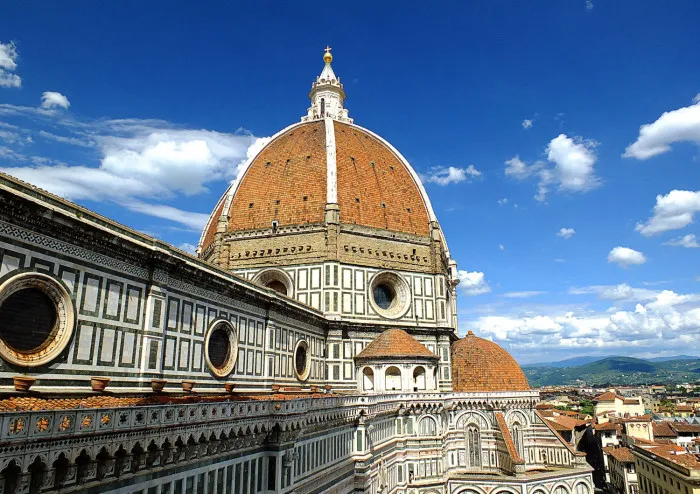
The Renaissance represents the cultural-historical period, from 14th to the 17th century. It is one of the most prominent movements in the culture of Western Europe, in many aspects of society, from politics, economics, art, literature, architecture, philosophy, and science. The Renaissance architecture reflects the “rebirth” (Rinascimento, in Italian) of Classical culture.
The historical framework of Renaissance architecture
Researchers agree that Renaissance architecture, as a stylistic form, was formed in Florence, the central city of Tuscany on the Apennine Peninsula. Florence, a city-state, had an administration made up of representatives of powerful trading families such as the Albizzi, Medici, Pitti, Strozzi, and others, who, above all others in Italy, understood the importance of innovations in various spheres of life.
In Tuscany, a new conception of artists taken shape, a new period in the history of architecture in terms of the social status of the author. One of the essential characteristics of the Renaissance became the universality of the personalities who create architecture.
The widespread enthusiasm for antiquity had an aesthetic and social aspect. A powerful urge for antiquity impressed scientists in later epochs. They called this period Renewal, Rinascita, Rinascimento, Renaissance.
Features of Renaissance architecture
Renaissance architecture, but also sculpture and painting are characterized by:
- Symmetry,
- Proportion,
- Geometry,
- Harmony,
- Cult of personality.
The world of the Renaissance artist was more complex than the world of predecessors. The artist was not only a friend of humanists, philosophers, and writers, but was a universally educated and versatile creator. Many were architects, sculptors, painters, scientists, and poets at the same time. Aimed at nature, they studied optics and established the laws of linear and aerial perspective. An important subject of the artist’s study was the human body, its anatomical structure, the laws of motion, and the proportions on which its beauty depends.

Renaissance architecture began in Florence before 1420. Its symbol is the Cattedrale di Santa Maria del Fiore, which was built by Filippo Brunelleschi in 1420, and completed after his death, in 1446.
This Italian architect intensively studied the methods of vaulting applied by builders of the Roman Empire. Brunelleschi became famous for that unique combination of modern, Gothic methods of construction, with the methods of ancient Rome. He thought that a Renaissance building must be easily constructed, so his geometric and mathematical values are simple. The law of symmetry was the main principle.
The most important buildings during the Renaissance in Florence are the Galleria degli Uffizi, Pitti Palace, Galleria dell’ Accademia, Basilica di Santa Croce, Ponte Vecchio, Giardino di Boboli, Palazzo Vecchio, Basilica di San Lorenzo, Piazza della Signoria, Villa Palmieri, Villa di Pratolino, and the great, magnificent Cattedrale di Santa Maria del Fiore. The significant architects are Filippo Brunelleschi, Leon Battista Alberti, Giorgio Vasari, Michelozzo, Leonardo da Vinci. There are much more, but these are the crucial names of Renaissance architecture.
Bilingualism
Renaissance architecture is one of those stylistic directions where a dual architectural language is common. One way of expression is constructive-structural, and the other is plastic. The technical structure of architectural creations does not have to correspond to the architectural articulation. It was a revolutionary idea in architecture because the decoration was separate from the construction and did not have to suit it completely.
The Renaissance language code was greatly expanded. It has become complex, it has significantly increased the number of elements for the communication process. The communication system is complex and consists of the internal relationship of the elements that make up a particular system, and that is a system of architectural associations.
The cult or absolute sign for communication in Renaissance architecture is the pillar. Its position greatly influences the architectural design of not only the interior but also the facade.
- The rough treatment of the stone facade is a metaphor for nature that surrounds us. This rough work in architecture is called in Italian – opera di natura.
- The fine treatment of the wall indicates that human consciousness refined the rough treatment and such treatment in Renaissance architecture is called in Italian – opera di mano.
The potential of decorative elements is fantastic
There are many decorative elements in Renaissance architecture, for example:
The use of color was specific and originated from the medieval tradition in Italy. It was the emphasis on the light-dark relationship (chiaroscuro) and the application of condensed light. The plasticity of the building is highlighted by the dark stone Pietra Serena which accentuated the elements of the facade.
Anthropomorphic measures usage in Renaissance architecture
Arithmetic and proportional relations of numbers are observed and basic and anthropomorphic geometry combined. The Renaissance also provides opportunities for subjective interpretation of symbols and stylistic elements.
Works of art are related to belonging to particular philosophical schools and cities. For example, Florence is famous for its famous academies, Leonardo da Vinci supported Aristotelian theories, and Michelangelo Buonarroti Platonic ideas, as seen in his artistic and architectural compositions.
Renaissance architects were writers as well
Interpreting Renaissance architecture takes place through metaphors, allegories, and stylistic figures, but also impressions, so that symbols no longer have a primary function in interpreting texts, as they had in the medieval context of creativity. Not only buildings are described, but also characters, and comparisons are made with interiors, where light, for example, has a primary function, as nature and its manifestation.
Ethics and aesthetics meet here, in the elements of creativity and all observed through the functionality of objects. Often everything resembles a stage, so space is given an additional element of poetics, theatricality, metaphor, but also the context is psychologically observed, especially in the late Renaissance, which leads to the Baroque vision of aesthetics.
If you want to add your personal piece of Italian Renaissance to your home, look for breathtaking Fine Art Photographs at Paolo Modena Photography

